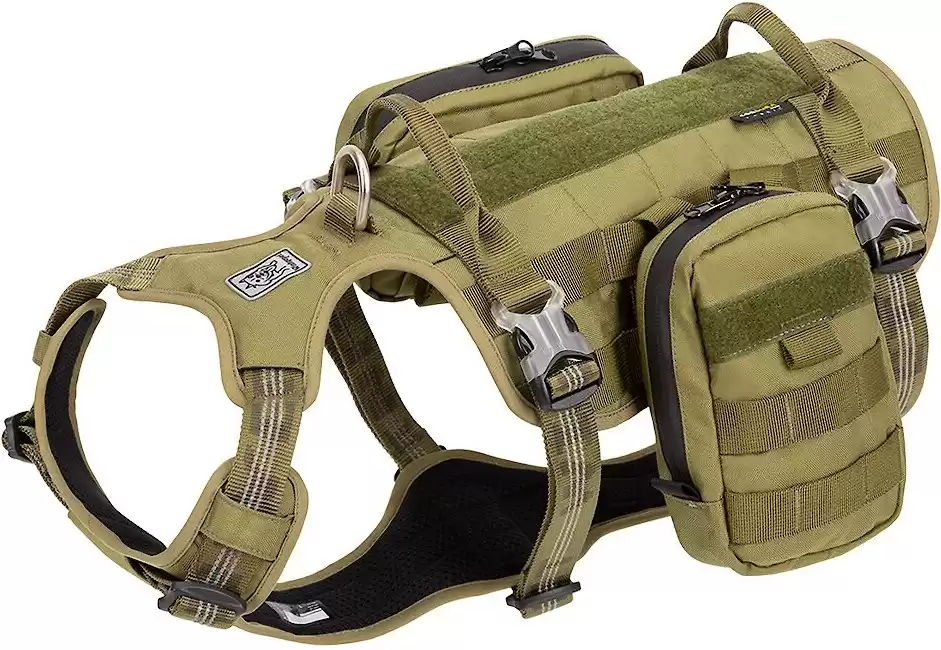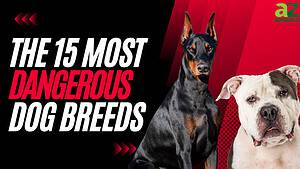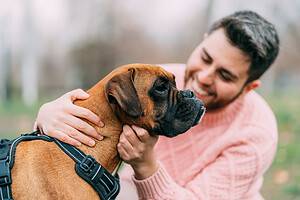A dog running towards you with a wagging tail feels like just about the best thing for a dog lover. In this situation, many people believe it’s an indication of enthusiasm and happiness. Perhaps you’ve even been with a dog whose tail would always thump loudly on the floor whenever it had its belly scratched. There are also very eager dogs whose strong tails can kind of hurt when they happily wag them with reckless abandon in your personal space! But, a wagging tail can have many different meanings depending on the situation. What does it really mean?
Tails Tell Emotional Tales
Humans have hundreds of muscles in our faces that help us to make complex facial expressions to communicate how we are feeling to other people. Dogs use their tails to communicate their emotions to other dogs and humans. The pace and positioning of the wagging indicate what emotion the dog is feeling. Dogs’ eyes are very sensitive to movement, making this a great way for dogs to communicate clearly with each other.
What Does a Low Tail Mean on a Dog?
When your dog’s tail is low, usually between its legs, the dog is showing fear, insecurity, or submission. Every dog owner knows that the tail often goes straight between the legs when the dog is reprimanded. Some dogs may also put their tail between their legs when they are sick or feeling under the weather.
What Does a High Tail Mean on a Dog?
If your dog’s tail is higher than usual, it may sense prey or something else lurking nearby. This is especially true in hunting breeds like pointers. These dogs instinctually point at prey nearby by stopping in their tracks, holding their tail high in the air, and lifting one paw off the ground.
A tail that is so high up that it is arched over the back may be a sign of aggression. Lifting up the tail this high releases more scent from the dog’s anal glands, marking the territory and letting others know to back off.
Have a look at this dog vest specially designed for hunting:
- Designed in a military-style
- Comes with pouches on the sides
- Ergonomic design
- Made from durable fabric
What Does a Neutral Tail Mean on a Dog?
A neutral tail is at its most usual height. A tail held firmly in the neutral position and not wagging may indicate curiosity or a desire to investigate. A wagging tail at neutral or slightly higher means happiness and enthusiasm.
Dog breeds have different relaxed tail heights. Many breeds’ tails hang down naturally. Greyhounds‘ tails usually are so low they curl beneath them when in a neutral position. However, some breeds, like beagles, are more upright. Other dog breeds, like pugs, have short tails that don’t wag as much as others.
What Does Tail Wagging Speed Indicate on a Dog?
The faster your dog is wagging their tail, the happier they are. When a dog wags its tail so fast that it looks like it may be vibrating, it is called flagging. Some dogs are so friendly that their wag turns into a full-body movement that includes the rear hips wiggling back and forth.
A low and slow wag indicates insecurity. A super high and fast wag can be an indication of aggression. Many people believe that if the dog is wagging its tail then it is happy. However, you can still get bit by a dog wagging its tail up high.
How Do Dogs With No Tails Express Themselves?
Some dogs naturally have very short tails that aren’t as expressive. Other dogs have been through an accident that resulted in the loss of their tail. These dogs may approach other dogs and strangers with caution because they can not communicate as well. They will also use other cues to determine what the other dog is trying to communicate.
Other Ways Dogs Use Body Language to Communicate
Tails aren’t the only cue that gives you some insight into what your dog is thinking. Pay close attention to these other cues to read into your dog’s feelings.
Hackles
Hackles are a special type of fur that dogs have along their shoulders and sometimes down their spine all the way to their tail. When a dog becomes aroused, due to something positive or negative, these hairs will raise up. It’s basically a response to a rush of adrenaline. It often happens in situations where the dog feels some aggression is necessary, but it can happen in situations of extreme happiness or playfulness as well.
Posturing
Dogs can move their bodies in different ways to show you what they think. For example, when a dog wants to play, it will often do a “play bow.” This is when the dog lowers their chest to the ground and puts its rear in the air, sometimes with a little jump.
Other postures to look for include hunching over. In some cases, this can indicate your dog is feeling sick to its stomach. Other times, it means your dog is afraid of something and is trying to make itself appear smaller and less threatening. Scared dogs may also lay on their backs and show their bellies as a sign of submission and vulnerability, to further prove they are not a threat. Peeing in this position is also a sign of submission.
If your dog suffers from a sensitive stomach, you can also give it a food specially formulated for sensitive stomachs, like:
- Easy to digest
- The main proteins are turkey liver and pork liver, not chicken
- Ideal for dogs that have difficulty digesting protein
- Includes prebiotic fiber, omega-3 fatty acid, and antioxidants
- Includes ginger to soothe irritated digestive tracts
Contrary to those positions, a dog that leans forward is often trying to make itself appear bigger, to intimidate something or someone, especially if the dog is making other aggressive movements. A forward lean without aggressive indicators could also indicate curiosity and interest.
Your dog’s paw positions can also indicate emotions. While pointers lift a paw to signal prey, other dog breeds often lift up one paw when they are uncertain of what to do next.
Facial Expressions
Even though dogs don’t have quite as many facial expressions as we do, they still do use their faces to communicate. Have you ever thought you caught a dog smiling? You’d be right! Some dogs do smile. In fact, Samoyed dogs are often called “smileys” because of how often they smile. However, a dog’s smile can look kind of scary to the untrained eye because they bare their teeth when smiling.
If a dog smiles with a relaxed posture, and a neutral wagging tail, it’s likely happy to see you. If it bares its teeth with an aggressive growl and posturing as previously described, it would be best to stay away.
Yawning
Dogs can yawn when they are tired, of course, but they may also have excessive yawning in stressful situations. Yawning often helps them to calm down. However, you can use this to your advantage. If you yawn at your dog in a stressful situation, like a grooming visit, they will yawn back which might help them to feel calmer. Yes, yawns are contagious between dogs and people too!
Licking the Lips
Many dogs lick their chops excessively when they are nervous. If your dog just ate, they are probably just making sure to get every single last bite, but if they haven’t, they may be expressing anxiety.
The Eyes
Dogs communicate a lot by either looking or not looking. When your dog stares intently at something, they are likely sensing a threat. Dogs may also look away to try to diffuse a situation. If you are reprimanding your dog, you may read your dog’s side-eye as them being upset with you, but they are likely trying to make the situation calmer in the best way they know how.
Ear Position
When your dog’s ears are in their usual position, they are relaxed and happy. If their ears are pressed back but not pressed against the head, your dog may be worried about something. If they are back and pressed more tightly to the head, plus other aggressive body signs, your dog is feeling confrontational or aggressive. Upright ears may indicate pointing towards prey or alerting to something.
How & Why to Read Dog Body Language
You must consider your dog’s whole body, from the tip of the ears to the tip of the tail, to truly read their body language.
Knowing how your dog is feeling can deepen your bond and make training more effective. Want to learn more about dog body language? Check out a dog training book or contact a dog trainer in your area.
- Great reading experience
- Lots of practical tips
- Include fun games
- Written by YouTube star Zak George
The photo featured at the top of this post is © Ramonki/Shutterstock.com
Ready to discover the top 10 cutest dog breeds in the entire world?
How about the fastest dogs, the largest dogs and those that are -- quite frankly -- just the kindest dogs on the planet? Each day, AZ Animals sends out lists just like this to our thousands of email subscribers. And the best part? It's FREE. Join today by entering your email below.
FAQs (Frequently Asked Questions)
Why Do Dogs Wag Their Tails?
Dogs use their tails to communicate their emotions to other dogs and humans.
Is it true that when dogs wag their tail they are happy?
A wagging tail can have many different meanings depending on the situation.
How do dogs smile?
Have you ever thought you caught a dog smiling? You’d be right! Some dogs do smile. In fact, Samoyed dogs are often called “smileys” because of how often they smile. However, a dog’s smile can look kind of scary to the untrained eye because they bare their teeth when smiling.
Thank you for reading! Have some feedback for us? Contact the AZ Animals editorial team.









